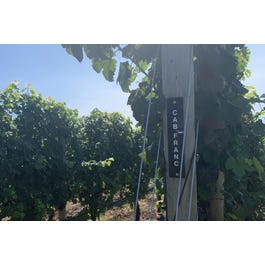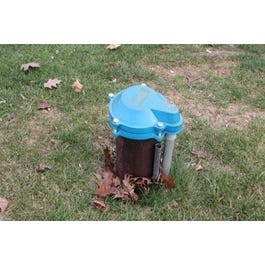
[ad_1]
Report #8: Week of October 14th
This is the eighth and final weekly report for the second season of Post-Veraison in Pennsylvania (PVIP), a grape maturation reporting system across Pennsylvania vineyards. Reports will consist of weekly grape ripening updates from cultivars that are planted widely across Pennsylvania (PA) vineyards (as based on feedback documented within Cultivars in the Commonwealth). Henceforth, PVIP reports will review the ripening patterns of some, or all, of the following cultivars: Cabernet franc, Chambourcin, Chardonnay, Riesling, and Vidal blanc. Due to the time required for grape samples to be shipped, processed, and analyzed, reports will reflect maturation from the previous week. Participating stakeholders for the 2024 edition of PVIP manage vineyards in the following Pennsylvania counties: Berks, Erie, Fayette, and Snyder; thanks to these stakeholders for their participation and collaboration on this project. If you have a commercial vineyard in Pennsylvania, please let us know if you are interested in participating in a future edition of PVIP.
The weather during the week of October 14 (last week) was generally cool but sunny and dry in many regions in PA. The result of the cooler weather and advanced stage of the vintage resulted in less progress in fruit maturation. The only Cabernet franc sample sent in from the week of October 14 was from Fayette County; from that site, the soluble solids was 23.5 Brix, pH was 3.49, and titratable acidity (TA) was 4.58 g/L. Thus, relative to the samples sent in from Fayette during the week of October 7, soluble solids increased by 1.5 Brix, pH increased by 0.11, and TA decreased by 0.52 g/L. Below is the “Cabernet franc report” from week 7 (samples taken during the week of October 7), the final report in which Cabernet franc fruit chemistry was measured from all four collaborator sites in 2024.
Week 7 (October 7) report for Cabernet franc:
When averaging fruit chemistry across the four “Cabernet franc sites” and comparing to last week’s report, soluble solids increased by 0.4 Brix, pH decreased by 0.08, and TA increased by 0.88 g/L (data not shown). With respect to primary chemistry, Cabernet franc was more mature in Berks (soluble solids = 24.1 Brix; pH = 3.64; TA = 6.83 g/L) and Fayette (soluble solids = 22.0; pH = 3.38; TA = 5.10 g/L) relative to Snyder (soluble solids = 20.8; pH = 3.42; TA = 12.60 g/L) and Erie (soluble solids = 22.3 Brix; pH = 3.34; TA = 6.38 g/L) (Figure 1). Relative to last week’s report, soluble solids increased in Berks (+2.4 Brix) and Erie (+1.8 Brix) but decreased in Fayette (-2.5 Brix) and Snyder (-0.3 Brix). Relative to last week’s report, pH increased by a range of 0.09 to 0.16 across Berks, Erie, and Snyder, and decreased (-0.07) in Fayette. Relative to last week’s report, TA minimally changed in Berks and Fayette but decreased by 1.58 g/L in Erie and increased by 5.25 g/L in Snyder. The following reviews average Cabernet franc fruit composition during similar calendar dates of 2023 and 2024. Across the four sites, average soluble solids was 1.4 Brix higher during the week of October 7, 2024 (22.3 Brix) relative to the week of October 9, 2023 (20.9 Brix) (Figure 2). Across the four counties, soluble solids ranged from -0.3 Brix (in Snyder) to 3.6 Brix (in Brix) higher during the week of October 7, 2024 relative to the week of October 9, 2023. Average pH values were 3.45 during the weeks of October 7, 2024 and October 9, 2023. Average TA values were greater during the week of October 7, 2024 (7.73 g/L) compared to October 9, 2023 (6.52 g/L).




From the remaining cultivars included in PVIP reports, only two Chambourcin samples were sent in from the week of October 14; one from Fayette and the other from Snyder. Riesling and Vidal blanc samples were either harvested before, or not sent in, from the week of October 14. In Fayette, Chambourcin soluble solids was 24.8 Brix; pH was 3.36; and titratable acidity (TA) was 5.63 g/L; in Snyder, Chambourcin soluble solids was 21.7 Brix, pH was 3.16, and titratable acidity (TA) was 7.80 g/L. Thus, relative to the samples sent in during the week of October 7, soluble solids increased by 1.0 Brix, pH increased by 0.11, and TA decreased by 0.0.98 g/L in Fayette, while soluble solids decreased by 1.9 Brix, pH decreased by 0.05, and TA increased by 0.15 g/L in Snyder. Below is the report from week 7 (samples taken during the week of October 7), which includes the final measurements for Riesling and Vidal blanc in 2024.
Week 7 (October 7) report for Chambourcin, Riesling, and Vidal blanc:
Compared to last week’s report across the three sites, Chambourcin soluble solids increased pH minimally changed, and TA increased (Table 1). Relative to last week’s report, Chambourcin soluble solids minimally decreased in Erie (-0.3 Brix) and increased in Fayette (+2.2 Brix) and Snyder (+1.5 Brix). Chambourcin pH minimally changed in Fayette and Snyder but increased by 0.09 in Erie. While Chambourcin TA minimally changed in Snyder, it decreased in Fayette (-1.05 g/L) and increased Erie (+6.08 g/L) (note: random samples may not always reflect the maturity status of the entire block). Relative to last week’s report from Erie, Riesling fruit composition parameters all increased (soluble solids = +1.7 Brix; pH = +0.13; TA = +4.05 g/L); the increase in Brix and pH are reflective of advancement in maturity. Relative to last week’s report from Erie,Vidal blanc soluble solids decreased (-5.1 Brix), and TA increased (+2.63 g/L), trends which reflect that maturation has slowed.
Adapted from the fifth PVIP report of 2024 (week of September 23):
Yeast assimilable nitrogen (YAN) was analyzed from fruit samples taken during the weeks of September 16 and September 23, 2024 (Table 2). YAN values can change dramatically over time. Factors impacting YAN include variety, weather, and foliar N sprays. For example, across all cultivars and locations, YAN ranged from 65 to 331 mg/L during the week of September 16, and from 45 to 315 mg/L during the week of September 23. In general, YAN values are lower in 2024 than in 2023, when YAN values ranged from 173 mg/L to 672 mg/L during the week of September 18, and from 108 mg/L to 475 mg/L during the week of October 2 (Table 3). The varied YAN levels observed between the two years and the two weeks within the years demonstrate the importance of measuring YAN levels for each cultivar as close to harvest as possible.
The following text only concerns the most recent samples from the week of September 23: Cabernet francYAN ranged from 45 mg/L (Snyder) to 92 mg/L (Berks); Chambourcin YAN ranged from 110 mg/L (Snyder) to 331 mg/L (Erie); Riesling YAN ranged from 105 mg/L (Erie) to 171 mg/L (Berks); Vidal blanc YAN was 315 mg/L in Erie and 68 mg/L in Snyder. In general, it was difficult to understand trends in YAN as a function of location or cultivar, particularly given the variability in report location/number for each cultivar. When averaged across cultivars, YAN was greatest in Vidal blanc (191 mg/L), followed by Chambourcin (181 mg/L), Riesling (135 mg/L), and Cabernet franc (66 mg/L). When averaged across locations, YAN was greatest in Erie (163 mg/L), followed by Berks (131 mg/L), Fayette (102 mg/L), and Snyder (74 mg/L).
Adapted from PVIP Report #5 in 2023:
Moderate YAN levels are recommended to achieve the best aroma/flavor profiles while ensuring complete fermentation. Typically, for a 24 Brix juice, one would aim for approximately 200-250 mg/L of YAN. Too little YAN can produce problems with hydrogen sulfide, whereas too much can also cause several problems.
When adjusting YAN, Organic N (vs DAP) is preferred to ensure a healthy ferment and achieve the best aromatic profile. Especially when large additions are needed, winemakers should plan to add YAN at two time points, half at the start of fermentation and the second half is added at 1/3 sugar depletion.
Pennsylvania stakeholders have reported harvest for several cultivars as the 2024 vintage comes to a close, including Albarino, Aravelle, Cabernet franc, Cabernet Sauvignon, Cayuga White, Chambourcin, Chardonel, Chardonnay, Concord, Marquette, Merlot, Nebbiolo, Niagara, Petite Pearl, Petit Verdot, Pinot noir, Riesling, Sauvignon Blanc, Seyval blanc, and Verona. Note that many cultivars have likely been harvested that are not yet listed here – this list represents a list of stakeholders that have provided recent updates to our team. If you have harvest updates you wish to be included in this report, please email them to viticulture@psu.edu.
We would like to acknowledge the hard work conducting the weekly analysis for these reports by Penn State graduate students Sujata Chatterjee and Ezekiel Warren and undergraduate students Angelena Minardi, Connor Gregory, and Joe Russo. The data in this report is possible due to the funding and support of the Pennsylvania Wine Marketing and Research Program. The authors and collaborators are grateful for the support.
[ad_2]
Source link






